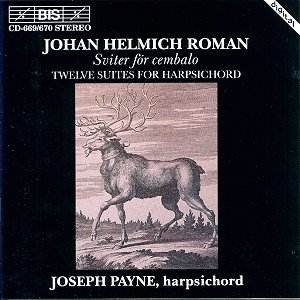 Composer: Johann Helmich Roman (1694-1758)
Composer: Johann Helmich Roman (1694-1758)
Works: Twelve Suites for Harpsichord
Performer: Joseph Payne, harpsichord
Rec. Date: January, February 1994, Forde Estate, Boston
Label: BIS CD-669/670 [2CDs: 138:44]
Review Date: November 2001
Johann Helmich Roman, often heralded as the “father of Swedish music” and dubbed the “Swedish Handel,” occupies a unique niche in the Baroque canon. His Twelve Suites for Harpsichord, presented here by Joseph Payne, reveal a composer straddling the line between the established Baroque traditions and the nascent sonata form that characterized the emerging Classical style. This recording, while showcasing the technical demands placed upon the performer, invites scrutiny into Roman’s compositional voice and the interpretative choices of the artist.
Roman’s suites, with their twelve distinct tonal centers, unfold in a manner reminiscent of the dance suites of his predecessors, yet they exhibit a forward-looking quality that hints at the evolution of musical form. The opening Suite I in E-flat major introduces the listener to Roman’s melodic proclivity, characterized by a playful yet measured Allegro that diverges from the more complex counterpoint of contemporaries such as Bach. Instead, we find a preoccupation with melody and a certain harmonic predictability. Suite VII’s structure, comprised of Moderato, Vivace, and Allegro, exemplifies this transitional style, as Roman leans toward a more liberated exploration of form, albeit without the contrapuntal intricacy that marks the works of his more celebrated predecessors.
Joseph Payne’s interpretation is marked by a palpable energy and affection for the material. His touch on the harpsichord is both sensitive and assertive, allowing for a wide dynamic range that articulates the buoyancy of the dance rhythms—an essential characteristic of Baroque suites. However, while Payne’s technical execution is commendable, the interpretative choices often lean toward the conventional, resulting in a performance that, while polished, can feel somewhat predictable. For instance, in Suite V in G minor, where the minor mode traditionally evokes a deeper emotional resonance, Payne’s rendering maintains a rather surface-level engagement with the material, lacking the gravitas that such a key signature can inspire.
In contrast, notable recordings by other harpsichordists, such as those by Andreas Staier or Pierre Hantaï, offer a more nuanced approach that delves into the emotional depths of the music. Staier, for instance, imbues his interpretations with a dramatic flair, particularly in the more introspective movements, thereby enhancing the listener’s experience of Roman’s harmonic language. By comparison, Payne’s treatment, while undeniably competent, sometimes veers toward a superficiality that does not entirely capture the essence of Roman’s intentions.
The recording quality by BIS is, as expected, of high standard. The clarity of the harpsichord is well-preserved, allowing the listener to appreciate the intricate details of the musical lines. The engineering captures the instrument’s resonance beautifully, creating an inviting auditory space. However, one might argue that the overall production, while technically sound, does not fully convey the emotive power that could elevate the performance beyond its competent execution.
Historically, Roman’s contributions are significant, as he laid the groundwork for Swedish classical music at a time when it was heavily influenced by foreign styles, particularly from France and Germany. His avoidance of the dense counterpoint typical of the Baroque period may reflect not a lack of ambition but rather a conscious choice to embrace a more lyrical and approachable style that resonated with the tastes of his contemporaries. Yet, this stylistic choice also leads to works that, while charming, can feel overly familiar.
In conclusion, while Joseph Payne’s performance of Roman’s Twelve Suites for Harpsichord is indeed a worthy addition to the harpsichord repertoire, it ultimately falls short of unveiling the deeper layers of Roman’s compositional voice. The energy and skill demonstrated by Payne are commendable, yet they do not suffice to elevate the music beyond its often predictable melodic lines. This recording may serve as an introduction to Roman’s work, but for a more profound engagement with the composer, listeners may find greater reward in the interpretations of those who dare to probe the emotional undercurrents of his music.



